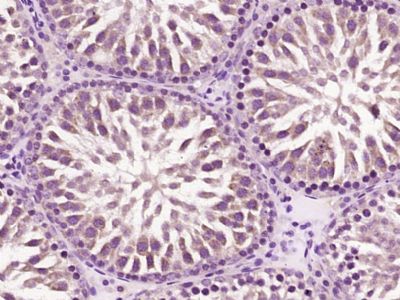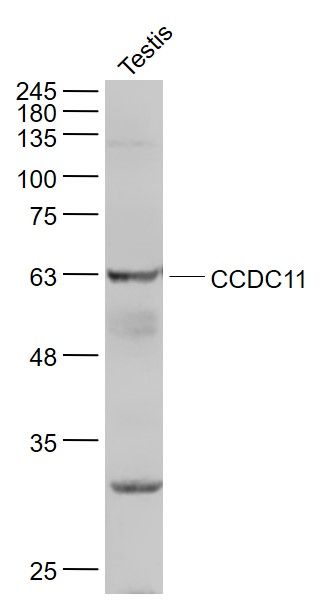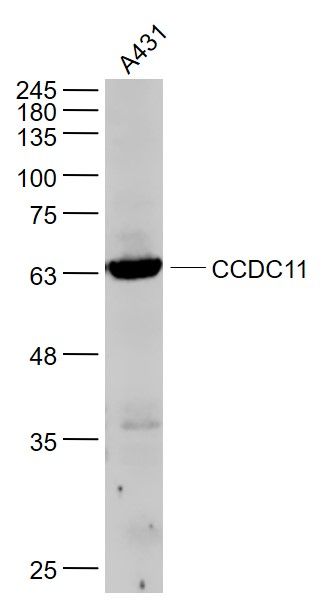CCDC11 Polyclonal Antibody
Purified Rabbit Polyclonal Antibody (Pab)
- 产品详情
- 实验流程
Application
| WB, IHC-P, IHC-F, IF, E |
|---|---|
| Primary Accession | Q96M91 |
| Reactivity | Rat, Bovine |
| Host | Rabbit |
| Clonality | Polyclonal |
| Calculated MW | 61835 Da |
| Physical State | Liquid |
| Immunogen | KLH conjugated synthetic peptide derived from human CCDC11 |
| Epitope Specificity | 331-430/514 |
| Isotype | IgG |
| Purity | affinity purified by Protein A |
| Buffer | 0.01M TBS (pH7.4) with 1% BSA, 0.02% Proclin300 and 50% Glycerol. |
| Important Note | This product as supplied is intended for research use only, not for use in human, therapeutic or diagnostic applications. |
| Background Descriptions | CCDC11 is a 514 amino acid protein encode by a gene that maps to human chromosome 18q21.1. Encoding over 300 genes, chromosome 18 contains about 76 million bases. Trisomy 18, or Edwards syndrome, is the second most common trisomy after Downs syndrome. Symptoms of Edwards syndrome include low birth weight, a variety of physical development defects, heart deformations and breathing difficulty. Translocation between chromosome 18 and 14 is the most common translocation in cancers, and occurs in follicular lymphomas. Niemann-Pick disease, hereditary hemorrhagic telangiectasia and erythropoietic protoporphyria are associated with chromosome 18. The TGF∫ modulators, Smad2, Smad4 and Smad7 are encoded by chromosome 18. |
| Gene ID | 220136 |
|---|---|
| Other Names | Cilia- and flagella-associated protein 53 {ECO:0000312|HGNC:HGNC:26530}, Coiled-coil domain-containing protein 11 {ECO:0000312|HGNC:HGNC:26530}, CFAP53 (HGNC:26530) |
| Dilution | WB=1:500-2000,IHC-P=1:100-500,IHC-F=1:100-500,IF=1:100-500,ELISA=1:5000-10000 |
| Format | 0.01M TBS(pH7.4) with 1% BSA, 0.09% (W/V) sodium azide and 50% Glyce |
| Storage | Store at -20 °C for one year. Avoid repeated freeze/thaw cycles. When reconstituted in sterile pH 7.4 0.01M PBS or diluent of antibody the antibody is stable for at least two weeks at 2-4 °C. |
| Name | CFAP53 (HGNC:26530) |
|---|---|
| Function | Microtubule inner protein (MIP) part of the dynein-decorated doublet microtubules (DMTs) in cilia axoneme, which is required for motile cilia beating (PubMed:36191189). Regulates motility patterns of both 9+0 and 9+2 motile cilia through differential localization and recruitment of axonemal dynein components (By similarity). Required for centriolar satellite integrity and non-motile cilium assembly (PubMed:26538025). Required for motile cilium formation (PubMed:26538025). Through its role in the beating of primary cilia, involved in the establishment of organ laterality during embryogenesis (PubMed:26531781). Required for sperm flagellum biogenesis and is essential for male fertility (By similarity). |
| Cellular Location | Cytoplasm, cytoskeleton, cilium axoneme. Cytoplasm, cytoskeleton, flagellum axoneme {ECO:0000250|UniProtKB:Q9D439} Cytoplasm, cytoskeleton, microtubule organizing center, centrosome, centriole. Cytoplasm, cytoskeleton, microtubule organizing center, centrosome, centriolar satellite. Cytoplasm, cytoskeleton, spindle pole. Cytoplasm, cytoskeleton. Cell projection, cilium. Note=In tracheal cell cilia, localizes prominently to both centriolar satellites and axonemes (By similarity) Tightly associated with microtubules in tracheal cilia (By similarity) In embryonic node cells, localizes to the base of the node cilia at the centriolar satellites and, to a lesser extent, to the cilium axoneme (By similarity). Localizes to centriolar satellites through G1, S phase, G2 and mitosis (PubMed:26538025). Enriched on the spindle poles in mitosis (PubMed:26538025). Relocalizes from the centriolar satellite to the ciliary transition zone upon ciliogenesis (PubMed:26538025). In skin fibroblast cells, locates predominantly to the centriole with much lower levels associated with the actin cytoskeleton (PubMed:28621423) Localizes to the sperm flagellum and manchette (By similarity) {ECO:0000250|UniProtKB:Q9D439, ECO:0000269|PubMed:26538025, ECO:0000269|PubMed:28621423} |
| Tissue Location | Expressed in skin fibroblasts (at protein level) (PubMed:22577226, PubMed:28621423). Expressed in nasal respiratory epithelial cells (at protein level) (PubMed:25504577). Expressed in airway epithelial cells (PubMed:36191189) |
Research Areas
For Research Use Only. Not For Use In Diagnostic Procedures.
Application Protocols
Provided below are standard protocols that you may find useful for product applications.
终于等到您。ABCEPTA(百远生物)抗体产品。
点击下方“我要评价 ”按钮提交您的反馈信息,您的反馈和评价是我们最宝贵的财富之一,
我们将在1-3个工作日内处理您的反馈信息。
如有疑问,联系:0512-88856768 tech-china@abcepta.com.























 癌症的基本特征包括细胞增殖、血管生成、迁移、凋亡逃避机制和细胞永生等。找到癌症发生过程中这些通路的关键标记物和对应的抗体用于检测至关重要。
癌症的基本特征包括细胞增殖、血管生成、迁移、凋亡逃避机制和细胞永生等。找到癌症发生过程中这些通路的关键标记物和对应的抗体用于检测至关重要。 为您推荐一个泛素化位点预测神器——泛素化分析工具,可以为您的蛋白的泛素化位点作出预测和评分。
为您推荐一个泛素化位点预测神器——泛素化分析工具,可以为您的蛋白的泛素化位点作出预测和评分。 细胞自噬受体图形绘图工具为你的蛋白的细胞受体结合位点作出预测和评分,识别结合到自噬通路中的蛋白是非常重要的,便于让我们理解自噬在正常生理、病理过程中的作用,如发育、细胞分化、神经退化性疾病、压力条件下、感染和癌症。
细胞自噬受体图形绘图工具为你的蛋白的细胞受体结合位点作出预测和评分,识别结合到自噬通路中的蛋白是非常重要的,便于让我们理解自噬在正常生理、病理过程中的作用,如发育、细胞分化、神经退化性疾病、压力条件下、感染和癌症。








